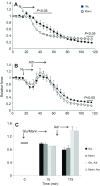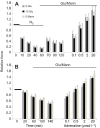Limited effects of exogenous glucose during severe hypoxia and a lack of hypoxia-stimulated glucose uptake in isolated rainbow trout cardiac muscle
- PMID: 23685969
- PMCID: PMC3749905
- DOI: 10.1242/jeb.085688
Limited effects of exogenous glucose during severe hypoxia and a lack of hypoxia-stimulated glucose uptake in isolated rainbow trout cardiac muscle
Abstract
We examined whether exogenous glucose affects contractile performance of electrically paced ventricle strips from rainbow trout under conditions known to alter cardiomyocyte performance, ion regulation and energy demands. Physiological levels of d-glucose did not influence twitch force development for aerobic preparations (1) paced at 0.5 or 1.1 Hz, (2) at 15 or 23°C, (3) receiving adrenergic stimulation or (4) during reoxygenation with or without adrenaline after severe hypoxia. Contractile responses to ryanodine, an inhibitor of Ca(2+) release from the sarcoplasmic reticulum, were also not affected by exogenous glucose. However, glucose did attenuate the fall in twitch force during severe hypoxia. Glucose uptake was assayed in non-contracting ventricle strips using 2-[(3)H] deoxy-d-glucose (2-DG) under aerobic and hypoxic conditions, at different incubation temperatures and with different inhibitors. Based upon a lack of saturation of 2-DG uptake and incomplete inhibition of uptake by cytochalasin B and d-glucose, 2-DG uptake was mediated by a combination of facilitated transport and simple diffusion. Hypoxia stimulated lactate efflux sixfold to sevenfold with glucose present, but did not increase 2-DG uptake or reduce lactate efflux in the presence of cytochalasin B. Increasing temperature (14 to 24°C) also did not increase 2-DG uptake, but decreasing temperature (14 to 4°C) reduced 2-DG uptake by 45%. In conclusion, exogenous glucose improves mechanical performance under hypoxia but not under any of the aerobic conditions applied. The extracellular concentration of glucose and cold temperature appear to determine and limit cardiomyocyte glucose uptake, respectively, and together may help define a metabolic strategy that relies predominantly on intracellular energy stores.
Keywords: 2-deoxyglucose; adrenaline; contractility; glucose; heart; hypoxia; lactate; rainbow trout; reoxygenation.
Figures






Similar articles
-
Dichloroacetate selectively improves cardiac function and metabolism in female and male rainbow trout.Am J Physiol Heart Circ Physiol. 2014 Nov 15;307(10):H1401-11. doi: 10.1152/ajpheart.00755.2013. Epub 2014 Sep 12. Am J Physiol Heart Circ Physiol. 2014. PMID: 25217653 Free PMC article.
-
Sex differences in energy metabolism and performance of teleost cardiac tissue.Am J Physiol Regul Integr Comp Physiol. 2007 Feb;292(2):R827-36. doi: 10.1152/ajpregu.00379.2006. Epub 2006 Oct 12. Am J Physiol Regul Integr Comp Physiol. 2007. PMID: 17038442
-
The regulation and importance of glucose uptake in the isolated Atlantic cod heart: rate-limiting steps and effects of hypoxia.J Exp Biol. 2004 May;207(Pt 11):1865-74. doi: 10.1242/jeb.00965. J Exp Biol. 2004. PMID: 15107441
-
Steroid-induced cardiac contractility requires exogenous glucose, glycolysis and the sarcoplasmic reticulum in rainbow trout.J Exp Biol. 2006 Jun;209(Pt 11):2114-28. doi: 10.1242/jeb.02241. J Exp Biol. 2006. PMID: 16709913
-
Effects of high extracellular [K+] and adrenaline on force development, relaxation and membrane potential in cardiac muscle from freshwater turtle and rainbow trout.J Exp Biol. 2001 Jan;204(Pt 2):261-8. doi: 10.1242/jeb.204.2.261. J Exp Biol. 2001. PMID: 11136612
Cited by
-
Exposure to an acute hypoxic stimulus during early life affects the expression of glucose metabolism-related genes at first-feeding in trout.Sci Rep. 2017 Mar 23;7(1):363. doi: 10.1038/s41598-017-00458-4. Sci Rep. 2017. PMID: 28337034 Free PMC article.
-
Unraveling the metabolic gene expression and energetic patterns of the seasonally acclimatized gilthead seabream.Fish Physiol Biochem. 2025 May 24;51(3):102. doi: 10.1007/s10695-025-01513-y. Fish Physiol Biochem. 2025. PMID: 40411699 Free PMC article.
-
Systemic Lactate Elevation Induced by Tobacco Smoking during Rest and Exercise Is Not Associated with Nicotine.Int J Environ Res Public Health. 2022 Mar 2;19(5):2902. doi: 10.3390/ijerph19052902. Int J Environ Res Public Health. 2022. PMID: 35270595 Free PMC article. Clinical Trial.
References
-
- Anousis N., Carvalho R. A., Zhao P., Malloy C. R., Sherry A. D. (2004). Compartmentation of glycolysis and glycogenolysis in the perfused rat heart. NMR Biomed. 17, 51-59 - PubMed
-
- Arthur P. G., Keen J. E., Hochachka P. W., Farrell A. P. (1992). Metabolic state of the in situ perfused trout heart during severe hypoxia. Am. J. Physiol. 263, R798-R804 - PubMed
-
- Bailey J. R., Driedzic W. R. (1993). Influence of low-temperature acclimation on fate of metabolic fuels in rainbow trout (Oncorhynchus mykiss) hearts. Can. J. Zool. 71, 2167-2173
-
- Bailey J. R., Rodnick K. J., MacDougall R., Clowe S., Driedzic W. R. (2000a). Anoxic performance of the American eel (Anguilla rostrata L.) heart requires extracellular glucose. J. Exp. Zool. 286, 699-706 - PubMed
Publication types
MeSH terms
Substances
Grants and funding
LinkOut - more resources
Full Text Sources
Other Literature Sources
Miscellaneous

